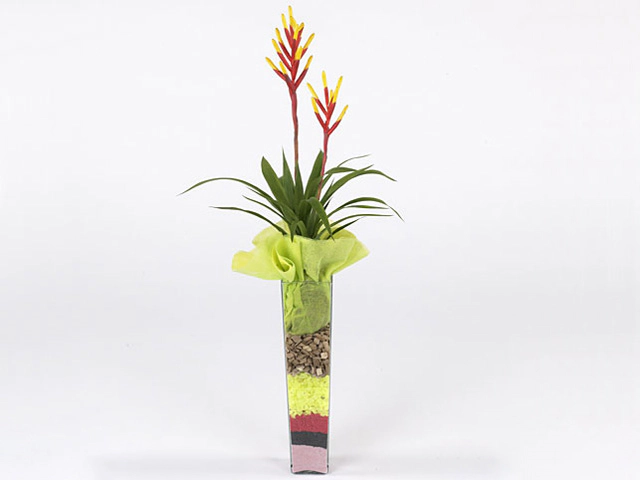Arrangementen Guzmania

Guzmania is a popular genus of bromeliads, known for their vibrant colors and unique flowering patterns. Among the various species in the Guzmania genus, one stands out particularly - the Scarlet Star. With its striking scarlet-colored bracts and striking yellow flowers, the Scarlet Star is a beautiful addition to any garden or indoor space.
The Scarlet Star belongs to the bromeliad family, which is native to the tropical regions of Central and South America. This bromeliad species thrives in warm and humid environments, making it a perfect choice for households or gardens located in such areas.
One of the main advantages of growing a Scarlet Star bromeliad is its ability to adapt to different lighting conditions. Whether you have a brightly lit room or a corner with minimal natural light, this plant can thrive in both scenarios. However, it is essential to avoid direct sunlight as it can damage the delicate foliage.
The Scarlet Star stands out not only for its vibrant colors but also for its unique growth pattern. Unlike many other bromeliads, this species is relatively compact and does not grow as tall. This makes it an excellent choice for small indoor spaces or grouping with other plants in a larger garden.
Taking care of a Scarlet Star bromeliad is relatively easy, making it a popular choice among gardening enthusiasts. Here are a few simple tips to ensure its well-being:
1. Temperature and Humidity: Keep the temperature between 60 to 80°F (15 to 27°C). Maintain high humidity levels by misting the leaves or placing the plant on a tray filled with water and pebbles.
2. Watering: Water the Scarlet Star's central rosette, ensuring it is not overfilled or completely dry. Use chlorine-free water to avoid damaging the plant.
3. Fertilizer: Use a weak liquid fertilizer specifically formulated for bromeliads during the growing season. Avoid using too much fertilizer, as it can burn the plant.
4. Propagation: Propagating the Scarlet Star bromeliad is relatively simple. Wait for the plant to produce offsets (also known as pups), then carefully separate them from the parent plant and pot them individually.
5. Pests and Diseases: While the Scarlet Star is generally resistant to pests and diseases, it is essential to keep an eye out for mealybugs or scale insects. If detected, treat the plant with an appropriate insecticide or wipe the affected areas with a damp cloth.
In conclusion, the Scarlet Star bromeliad is a visually striking and easy-to-maintain plant that can bring a touch of tropical beauty to any space. Whether displayed as a standalone plant or incorporated into a larger garden arrangement, its vibrant colors and unique growth pattern are sure to captivate any gardening enthusiast. Consider adding a Scarlet Star bromeliad to your collection and enjoy the beauty it brings.
Market availability index by month:
| Jan. | Feb. | Mar. | Apr. | May | Jun. | Jul. | Aug. | Sep. | Oct. | Nov. | Dec. |
|---|---|---|---|---|---|---|---|---|---|---|---|
| 4 | 4 | 3 | 3 | 3 | 3 | 3 | 3 | 3 | 3 | 3 | 3 |